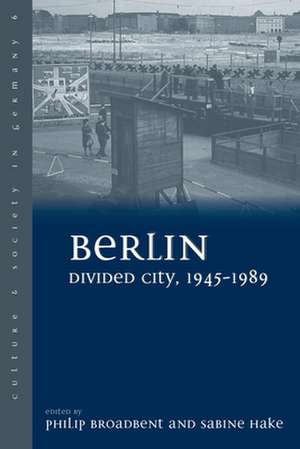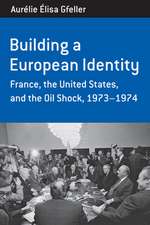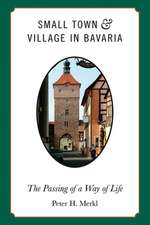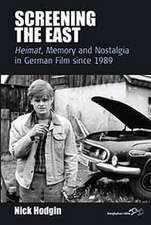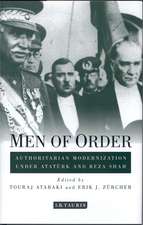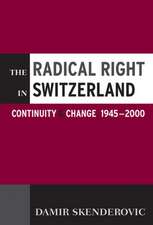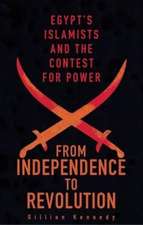Berlin Divided City, 1945-1989: Culture and Society in Germany
Autor German Studies Workshop (2nd 2008 Univer Editat de Philip Broadbenten Limba Engleză Hardback – 14 aug 2010
Din seria Culture and Society in Germany
-
 Preț: 258.88 lei
Preț: 258.88 lei -
 Preț: 266.18 lei
Preț: 266.18 lei -
 Preț: 258.07 lei
Preț: 258.07 lei -
 Preț: 221.70 lei
Preț: 221.70 lei - 23%
 Preț: 747.84 lei
Preț: 747.84 lei -
 Preț: 259.80 lei
Preț: 259.80 lei
Preț: 748.72 lei
Preț vechi: 972.37 lei
-23% Nou
Puncte Express: 1123
Preț estimativ în valută:
143.26€ • 149.98$ • 118.54£
143.26€ • 149.98$ • 118.54£
Carte tipărită la comandă
Livrare economică 05-19 aprilie
Preluare comenzi: 021 569.72.76
Specificații
ISBN-13: 9781845457556
ISBN-10: 1845457552
Pagini: 222
Dimensiuni: 156 x 234 x 14 mm
Greutate: 0.49 kg
Editura: BERGHAHN BOOKS INC
Seria Culture and Society in Germany
Locul publicării:United Kingdom
ISBN-10: 1845457552
Pagini: 222
Dimensiuni: 156 x 234 x 14 mm
Greutate: 0.49 kg
Editura: BERGHAHN BOOKS INC
Seria Culture and Society in Germany
Locul publicării:United Kingdom
Cuprins
List of Illustrations Acknowledgments Introduction: Philip Broadbent and Sabine Hake PART ONE: COLD WAR BEGINNINGS 1. Jennifer Evans: Life Among the Ruins: Sex, Space, and Subculture in Zero Hour Berlin 2. Maike Steinkamp: The Propagandistic Role of Modern Art in Postwar Berlin 3. Elizabeth Janik: Back to the Future: New Music's Revival and Redefinition in Occupied Berlin 4. Greg Castillo: The Nylon Curtain: Architectural Unification in Divided Berlin 5. Heiner Stahl: Mediascape and Soundscape: Two Landscapes of Modernity in Cold War Berlin PART TWO: EAST BERLIN, THE SOCIALIST CAPITAL 6. April Eisman: Painting the Berlin Wall in Leipzig: The Politics of Art in 1960s East Germany 7. Mariana Ivanova: You Have to Draw a Line SomewhereA": Tropes of Division in DEFA Films from the early 1960s 8. Heather Gumbert: Building the East German Television Tower 9. Deborah Asher Barnstone: Transparency in Divided Berlin: The Palace of the Republic PART THREE: WEST BERLIN, SHOWCASE OF THE WEST 10. Ulrich Bach: I Still Have a Suitcase in BerlinA": Hildegard Knef's Cold War Movies 11. David Barclay: Benno Ohnesorg, Rudi Dutschke, and the Student Movement in West Berlin: Critical Reflections after Forty Years 12. Claudia Mesch: Berlin and Post-Meinhof Feminism: Yvonne Rainer's Journeys from Berlin/1971 13. Paul Jaskot: Daniel Libeskind's Jewish Museum in Berlin as a Cold War Project 14. Emily Pugh: Beyond the Berlin Myth: the Local, the Global and IBA 87 PART FOUR: BERLIN AFTER UNIFICATION: LOOKING BACK AND BEYOND 15. Miriam Paeslack: Stereographic City: Berlin Photography in the Wende Era 16. Lyn Marven: Divided City, Divided Heaven? Berlin Border Crossings in Post-Wende Fiction 17. Interview with Barbara Hoidn Notes on Contributors Index
Notă biografică
Philip Broadbent is Assistant Professor in the Department of Germanic Studies at the University of Texas at Austin. He has published on literary representations of post-1990 Berlin and contemporary European fiction. His current book project looks at the emergence of cool aesthetics in West Germany. Sabine Hake is the Texas Chair of German Literature and Culture in the Department of Germanic Studies at the University of Texas at Austin. She is the author of five books, including German National Cinema (2008, 2nd rev. ed.) and Topographies of Class: Modern Architecture and Mass Society in Weimar Berlin (2008). She has published numerous articles and edited volumes on German film and Weimar culture. Her current book project deals with the fascist imaginary in post-fascist cinema.
